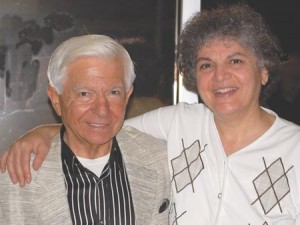Ruzan Orkusyan
Staff Writer

Photo: Erica Magarian
On Friday, October 29, the Armenian Studies Program sponsored yet another presentation in its Fall 2010 Lecture Series — one that explored the brilliant heights of Mt. Aragats, the forbidden summit of Mt. Ararat, and beyond, into the mysteries of the sky.
Anahid Yeremian, a particle accelerator physicist at Stanford University since 1990, gave a fascinating and exhilarating lecture about the Cosmic Ray Division (CRD) of Armenia, immersing the audience into the complicated yet exciting world of physics. She works with scientists around the globe and since 1999 has been working with scientists at the Alikhanyan National Laboratory, formerly called the Yerevan Physics Institute (where CRD’s stations are located).
Yeremian began by briefly talking of the history and the facilities of the CRD founded by the Alikhanyan brothers in 1943 on Mt. Aragats. Today, the CRD is directed by Professor Ashot Chilingarian, who works tirelessly to put Armenia at the forefront of ground based space weather forecasting, one of the top 5 such stations in the world, using the buildings for research year round during the three-week shifts.
The CRD’s areas of expertise include high-energy astrophysics, solar physics, space weather research, and charged atmosphere research among other things. Yeremian described cosmic rays as particles and radiation that come from the sun and very distant stars. The scientists at CRD, using detectors, capture these particles and examine their fundamental structure and composition. The particles coming from the sun affect everything from satellites to astronauts and the space weather research conducted at the CRD can help warn scientists around the world about solar flares that can have adverse affects on our energy sources.
One of the struggles the CRD faces is keeping Armenia’s brainpower in Armenia. That is why they concentrate on giving young students not only an education but also employment after school.
The CRD’s work is important and highly praised by experts everywhere. They are constantly expanding their research and developing new tools and machinery to make their research easier. With the expertise of the workers and the help of the Diaspora they are collecting data that will prove crucial.
Following this exciting lecture, the audience was captivated by an emotional video presented by Fresno native Vatche Soghomonian, who in July of this year climbed to the peak of Mt. Ararat with a team of American-Armenians. They hoisted the Armenian and Nagorno-Karabakh flags on the peak.
Soghomonian frequently travels to Armenia; in fact, every summer he participates in a bike-a-thon to help raise money for different organizations and orphanages in the homeland. This year, the bike-a-thon was dedicated to the CRD.
Soghomonian left Fresno on what his wife called yet another “suicide mission” and with his team of ten others crossed the Turkish border in order to climb the mountain. They were stopped and questioned by Turkish police whom informed of their intention to climb Mt. Ararat — however, one look at Sohomonian and the Turkish officer began laughing and even wanted a picture with him. He thought the mission was impossible.
On July 15 the team of eleven, led by a Kurdish guide, began the treacherous climb up Mt. Ararat. Small rocks became giant boulders as the climb continued, the terrain was rough and on the second night at Camp II there was “hail from hell.” Nevertheless, the third day they pushed for the summit at 17,500 feet, through ice and winds up to 40mph. And finally they reached their goal. As the audience watched the footage of the team holding the two flags on the summit, barely breathing, and the dark clouds moving rapidly in the skies beyond, not a dry eye could be detected in the hall. Everyone was truly touched and full of pride, admiring Soghomonian and his team for this daring act.
Mt. Ararat is a distant dream for many Armenians, but through the pictures, video, and description of Sohomonian, all were able to visit this sacred place.
 Hye Sharzhoom Armenian Action
Hye Sharzhoom Armenian Action